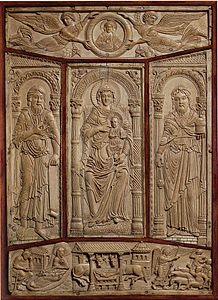Còdex Auri de Lorsch
 | |
| Tipus | evangeliari i manuscrit il·luminat |
|---|---|
| Llengua | llatí |
| Creació | 810 |
| Format per | Five plaques from the front cover of the Lorsch Gospels (en) Vatican, Bib. Apostolica, MS. Pal. lat. 50 (en) Bucharest, National Library of Romania (Alba lulia, Batthyaneum Library), Ms R II 1 (en) |

El Còdex Auri de Lorsch o Evangelis de Lorsch (Biblioteca Apostòlica Vaticana, Pal. lat. 50 i Alba Iulia, Biblioteca Documenta Batthyaneum, s. núm.) és un manuscrit il·luminat escrit entre 778 i 820, en el període del regnat de Carlemany al Regne franc.
Història
[modifica]Potser fou escrit a l'abadia de Lorsch (Alemanya), que tenia una de les millors biblioteques del món en els segles x i xi, amb el nom de Codex Aureus Laurensius. En el segle XVI, el manuscrit fou traslladat a Heidelberg, a la famosa Biblioteca Palatina. El còdex en fou furtat al 1622 durant la Guerra dels Trenta anys i esquarterat per poder vendre'l més fàcilment. La ricament il·lustrada primera part, ara a Alba Iulia, Romania, fou venuda a la família Batthyány (1741 – 1798). La segona part és a la Biblioteca Vaticana, amb la contraportada als Museus Vaticans. La coberta és hui en el Victoria and Albert Museum de Londres.[1]
Un facsímil del còdex li va regalar a la reina Elisabeth II el papa Benet XVI el 16 de setembre de 2010, que, en bescanvi, va rebre una sèrie de gravats de Hans Holbein el Jove, que formaven part de la Col·lecció Reial.[2] Hi ha disponible en línia una versió completa de l'obra.[3]
Localització
[modifica]Les diferents parts originals estan localitzades en:
- Biblioteca de Batthyaneum, a Alba Iulia, Romania: Evangelis de Mateu i Marc
- Biblioteca del Vaticà: Evangelis de Lluc i Joan
- Victoria and Albert Museum, Londres: els panells d'ivori de la coberta
Galeria
[modifica]-
Contracoberta d'ivori
Referències
[modifica]- ↑ Illustration; Herbert Schultz, p. 283, The Carolingians in Central Europe, their history, arts, and architecture: a cultural history of Central Europe, 750-900, BRILL, 2004, ISBN 90-04-13149-3, ISBN 978-90-04-13149-1
- ↑ Visita del papa a Anglaterra, The Guardian, 16/09/2010.
- ↑ Pal. lat. 50 (Vatican, Biblioteca Apostolica Vaticana) Arxivat 2013-04-25 a Wayback Machine. - digital facsimile (na sua maior parte em Inglês)], com imagens maiores que versão na Biblioteca Nacional da Romênia Arxivat 2020-07-23 a Wayback Machine.
Vegeu també
[modifica]Bibliografia
[modifica]- Walther, Ingo F. and Norbert Wolf. Codices Illustres: The world's most famous illuminated manuscripts, 400 to 1600. Köln, TASCHEN, 2005.
Enllaços externs
[modifica]- Lorsch Gospels - digital facsimile (Bibliotheca Laureshamensis - digital).
- Descripció en alemany Arxivat 2016-05-01 a Wayback Machine..
Text is available under the CC BY-SA 4.0 license; additional terms may apply.
Images, videos and audio are available under their respective licenses.





